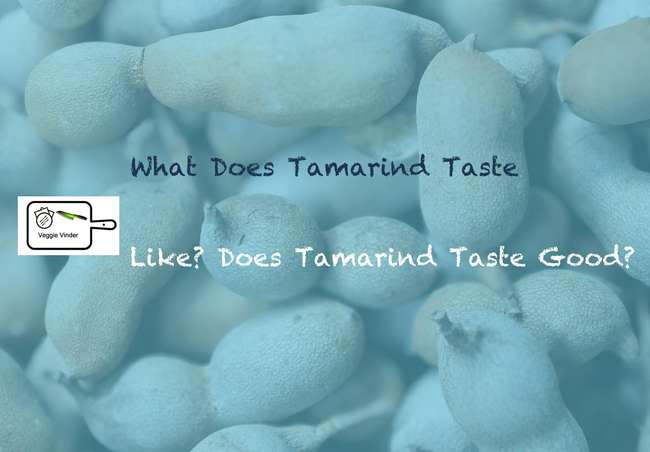What Does Tamarind Taste Like? Does Tamarind Taste Good?
Tamarind is a fruit native to Africa and India.
It has a sweet taste and is often used in Indian cuisine.
What does tamarind taste like?
How does it compare to other fruits?
Tasting tamarind is fun because it tastes very similar to mangoes.
The only difference is that tamarind is sour, whereas mangoes are sweet.
Tamarind is also known as the Indian date or the African date palm.
It grows in tropical climates and is usually found in India and Africa
What is Tamarind?
Tamarind is a fruit that grows in tropical climates. It is native to Africa and Asia. It is used extensively in Indian cuisine. In India, tamarind is called "Imli" and is used in many dishes. Tamarind is sour, tangy, sweet and salty. It is used in curries, chutneys, pickles, sauces, breads, sweets, drinks and desserts. It is available in powder form or as a paste.

What Forms Does Tamarind Come in and How is It Used?
Tamarind comes in different forms such as pulp, concentrate, paste, syrup, powder, and extract. Pulp – This is the dried version of the fruit. It is usually sold in blocks and needs to be soaked in hot water to soften it. Concentrate – This is the concentrated version of the fruit. Usually, it is sold in bottles. It is diluted with water to get the desired consistency.
Health and Nutritional Benefits of Tamarind
Tumeric is a spice that is used extensively in Indian cuisine. It is a member of the ginger family and is native to India. It is widely used in South Asian cuisines and is also popular in other parts of Asia. It is known by many names, including turmeric, Indian saffron, and Kashmiri saffron. It is a bright yellow color and has a distinct flavor. It is available in two forms – ground and whole. Ground tumeric is used in curries, soups, and stews. Whole tumeric is used in pickles, chutneys, and marinades. Tumeric is rich in antioxidants and anti-inflammatory properties. It contains vitamin C, iron, calcium, zinc, magnesium, manganese, copper, and selenium. These nutrients help boost immunity and improve overall health. It is also beneficial for digestion and helps prevent cancer. Tumeric is also good for skin care. It reduces inflammation and protects against sun damage. It is also helpful in treating acne and psoriasis.
What Does Tamarind Taste Like?
Tamarind is sour and sweet. It tastes similar to tamarind pulp mixed with sugar. It is also called tamarind paste. It is a common ingredient in Indian dishes. It is used in sauces and gravies. It is also added to chutneys and pickles.
6 Ways to Use Tamarind in Cooking
1 Add tamarind pulp to curries, soups, stews, and other savory dishes. 2 Make a thick sauce using tamarind pulp and coconut milk. 3 Mix tamarind juice with vinegar and sugar to make a tangy dressing. 4 Add tamarind to chili powder to give it a tart flavor. 5 Use tamarind in place of lime juice in marinades. 6 Try adding tamarind to desserts such as mango lassis and ice creams.
How to Buy and Store Tamarind Paste
Tamarind paste comes in two forms – dry and liquid. Dry tamarind is available in a block form and needs to be soaked in hot water to soften it. Liquid tamarind is sold in bottles and cans and requires no soaking. Both forms are used in Indian cuisine.
What Does Tamarind Taste Like? Does Tamarind Taste Good?
Tamarind is sour in taste. It tastes good when added to curries, chutneys and pickles. It is also used in many desserts such as kulfi Indian ice cream and halwa sweet. How to Make Tamarind Paste? Answer: To make tamarind paste, soak 1/2 cup of dried tamarind in 2 cups of warm water for about 10 minutes. Remove the seeds from the tamarind pods using a spoon. Grind the tamarind into a smooth paste. Add salt if required. Use the tamarind paste immediately or store in airtight containers.
Why is tamarind so tasty?
Tamarind is used as a sour in many dishes in India and other parts of Asia. It is used as souring agent in curried dishes, chutneys, sauces, pickles, and desserts. It is also used in sweets like kheer Indian dessert and halwa.
What is tamarind good for?
Tamarind is used in many dishes in India. It is used as a souring agent in curries, chutneys, pickles, and sauces. Tamarind is also used in sweets such as kheer Indian dessert, gulab jamun, and halwa. How to get rid of tamarind smell from clothes? Answer: To remove the tamarind smell from your clothes, soak the garment in hot water mixed with lemon juice. This will help to neutralize the odor.
What is tamarind candy good for?
Tamarind is sweet and sour. It has a unique flavor. It is very popular in Indian cuisine.
Why is tamarind so sour?
Tamarind is a fruit from India and Africa. It is used in many dishes around the world. It is sour and sweet. It is used in sauces, soups, curries, chutneys, pickles, jams, jellies, drinks, ice creams, desserts, breads, and even candies. What does tamarind taste like? Answer: Tamarind tastes like candy because tamarind contains sugar. Tamarins are sweetened with sugar and it is a natural product. It is not only tasty but also healthy.
How is tamarind taste?
Tamarind tastes like candy because it contains sugar. Tamarind is sweetened with sugar and other ingredients. It is not only delicious but also healthy.
Does tamarind taste like the candy?
Tamarind is a very sour fruit. Its seeds are bitter and acidic. To remove the bitterness from the seed, tamarind is soaked in warm water overnight. Then the seeds are removed and the pulp is squeezed out. The resulting liquid is called tamarind juice. It is used in various recipes such as chutneys, pickles, sauces, soups, and drinks.
How would you describe tamarind?
Tamarind is a fruit that grows in tropical climates. It is used as a natural sweetener and preservative. Tamarind pods are dried and ground into powder form. This powder is added to dishes to give them a tangy flavor. In India, tamarind is used extensively in curries and other Indian dishes. It is used in many desserts and sweets.
